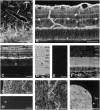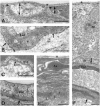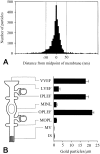Aquaporin-4 water channel protein in the rat retina and optic nerve: polarized expression in Müller cells and fibrous astrocytes
- PMID: 9502811
- PMCID: PMC6793100
- DOI: 10.1523/JNEUROSCI.18-07-02506.1998
Aquaporin-4 water channel protein in the rat retina and optic nerve: polarized expression in Müller cells and fibrous astrocytes
Abstract
The water permeability of cell membranes differs by orders of magnitude, and most of this variability reflects the differential expression of aquaporin water channels. We have recently found that the CNS contains a member of the aquaporin family, aquaporin-4 (AQP4). As a prerequisite for understanding the cellular handling of water during neuronal activity, we have investigated the cellular and subcellular expression of AQP4 in the retina and optic nerve where activity-dependent ion fluxes have been studied in detail. In situ hybridization with digoxigenin-labeled riboprobes and immunogold labeling by a sensitive postembedding procedure demonstrated that AQP4 and AQP4 mRNA were restricted to glial cells, including MHller cells in the retina and fibrous astrocytes in the optic nerve. A quantitative immunogold analysis of the MHller cells showed that these cells exhibited three distinct membrane compartments with regard to AQP4 expression. End feet membranes (facing the vitreous body or blood vessels) were 10-15 times more intensely labeled than non-end feet membranes, whereas microvilli were devoid of AQP4. These data suggest that MHller cells play a prominent role in the water handling in the retina and that they direct osmotically driven water flux to the vitreous body and vessels rather than to the subretinal space. Fibrous astrocytes in the optic nerve similarly displayed a differential compartmentation of AQP4. The highest expression of AQP4 occurred in end feet membranes, whereas the membrane domain facing the nodal axolemma was associated with a lower level of immunoreactivity than the rest of the membrane. This arrangement may allow transcellular water redistribution to occur without inducing inappropriate volume changes in the perinodal extracellular space.
Figures








Similar articles
-
Immunogold evidence suggests that coupling of K+ siphoning and water transport in rat retinal Müller cells is mediated by a coenrichment of Kir4.1 and AQP4 in specific membrane domains.Glia. 1999 Mar;26(1):47-54. doi: 10.1002/(sici)1098-1136(199903)26:1<47::aid-glia5>3.0.co;2-5. Glia. 1999. PMID: 10088671
-
Select types of supporting cell in the inner ear express aquaporin-4 water channel protein.Eur J Neurosci. 1998 Dec;10(12):3584-95. doi: 10.1046/j.1460-9568.1998.00360.x. Eur J Neurosci. 1998. PMID: 9875338
-
Specialized membrane domains for water transport in glial cells: high-resolution immunogold cytochemistry of aquaporin-4 in rat brain.J Neurosci. 1997 Jan 1;17(1):171-80. doi: 10.1523/JNEUROSCI.17-01-00171.1997. J Neurosci. 1997. PMID: 8987746 Free PMC article.
-
Aquaporin-4 in the central nervous system: cellular and subcellular distribution and coexpression with KIR4.1.Neuroscience. 2004;129(4):905-13. doi: 10.1016/j.neuroscience.2004.08.053. Neuroscience. 2004. PMID: 15561407 Review.
-
Aquaporin-4 in Astroglial Cells in the CNS and Supporting Cells of Sensory Organs-A Comparative Perspective.Int J Mol Sci. 2016 Aug 26;17(9):1411. doi: 10.3390/ijms17091411. Int J Mol Sci. 2016. PMID: 27571065 Free PMC article. Review.
Cited by
-
Optic nerve head: A gatekeeper for vitreous infectious insults?Front Immunol. 2022 Sep 20;13:987771. doi: 10.3389/fimmu.2022.987771. eCollection 2022. Front Immunol. 2022. PMID: 36203577 Free PMC article.
-
Regulation of astrocyte glutamine synthetase in epilepsy.Neurochem Int. 2013 Dec;63(7):670-81. doi: 10.1016/j.neuint.2013.06.008. Epub 2013 Jun 18. Neurochem Int. 2013. PMID: 23791709 Free PMC article. Review.
-
Aquaporin water channels in the nervous system.Nat Rev Neurosci. 2013 Apr;14(4):265-77. doi: 10.1038/nrn3468. Epub 2013 Mar 13. Nat Rev Neurosci. 2013. PMID: 23481483 Free PMC article. Review.
-
Comparative Quantitative Analysis of Porcine Optic Nerve Head and Retina Subproteomes.Int J Mol Sci. 2019 Aug 29;20(17):4229. doi: 10.3390/ijms20174229. Int J Mol Sci. 2019. PMID: 31470587 Free PMC article.
-
In vivo measurement of brain extracellular space diffusion by cortical surface photobleaching.J Neurosci. 2004 Sep 15;24(37):8049-56. doi: 10.1523/JNEUROSCI.2294-04.2004. J Neurosci. 2004. PMID: 15371505 Free PMC article.
References
-
- Amédée T, Robert A, Coles JA. Potassium homeostasis and glial energy metabolism. Glia. 1997;21:46–55. - PubMed
-
- Andrew RD, MacVicar BA. Imaging cell volume changes and neuronal excitation in the hippocampal slice. Neuroscience. 1994;62:371–383. - PubMed
-
- Brew H, Gray PTA, Mobbs P, Attwell D. Endfeet of retinal glial cells have higher densities of ion channels that mediate K+ buffering. Nature. 1986;324:466–468. - PubMed
Publication types
MeSH terms
Substances
LinkOut - more resources
Full Text Sources
Research Materials
